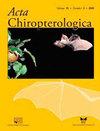A New Species of Horseshoe Bat (Chiroptera: Rhinolophidae) from Mount Namuli, Mozambique
IF 0.7
4区 生物学
Q4 ZOOLOGY
引用次数: 0
Abstract
The ecology of the high-altitude mountains of northern Mozambique is understudied in comparison to surrounding countries. A series of biological surveys have focused on filling this data gap, with Mount Namuli in Zambezia Province one of the focal sites of these expeditions. A biological survey of Mount Namuli in 2009 resulted in the collection of five specimens of a horseshoe bat species (Rhinolophidae) that is here described as a new species from Mozambique. Morphologically, the new species is very similar to Rhinolophus maendeleo Kock, Csorba and Howell, 2000 of the adami-group, but lacks some key morphological characters of this group (large ears, narrow skull, long palate). Molecular reconstructions clearly suggest the new species belongs to the capensis-group, but no members of the adami-group were included in this analysis (due to lacking data). It is thus unclear whether this unexpected phylogenetic position reflects morphological convergences between members of the adami- and capensis-groups, or whether the morphology-based adami-group should be reconsidered. The new species and R. maendeleo share similar external and craniodental measurements, but can be distinguished based on a number of key characters. These include the presence of a bony bar forming the interorbital foramena, rostrum shape, ear length and highly differing bacular morphologies. It also differs from the genetically closely related R. denti Thomas, 1904, R. swinnyi Gough, 1908 (including two recently described cryptic species) and R. simulator Andersen, 1904 by non-overlapping external and cranial measurements. The new species echolocates at a mean peak frequency of 76.9 kHz and shows an affinity to forest habitats, which are highly threatened in the surrounding region. It joins other coastal and montane forest endemics in defining the bat fauna of south-eastern Africa.莫桑比克纳穆利山马蹄蝙蝠一新种(翼手目:犀科)
与周边国家相比,莫桑比克北部高海拔山脉的生态学研究不足。一系列生物调查的重点是填补这一数据空白,赞比西亚省的纳穆利山是这些探险的焦点之一。2009年对纳穆利山进行的一次生物调查收集了五个马蹄蝙蝠物种(犀科)的标本,该物种在这里被描述为莫桑比克的一个新物种。在形态上,这个新物种与阿达米群的Rhinolophus maendeleo Kock、Csorba和Howell,2000非常相似,但缺乏该群的一些关键形态特征(大耳朵、窄头骨、长腭)。分子重建清楚地表明,这个新物种属于capensis群,但由于缺乏数据,该分析中没有阿达米群的成员。因此,目前尚不清楚这种出乎意料的系统发育位置是否反映了阿达米群和卡彭斯群成员之间的形态学趋同,或者是否应该重新考虑基于形态学的阿达米群。新物种和R.maendeleo具有相似的外部和颅骨测量结果,但可以根据一些关键特征进行区分。其中包括形成眶间孔的骨条的存在、喙部形状、耳朵长度和高度不同的杆状形态。它还与基因亲缘关系密切的R.denti Thomas,1904年,R.swinnyi Gough,1908年(包括两个最近描述的神秘物种)和R.simulator Andersen,1904年的不同之处在于外部和颅骨测量不重叠。新物种的回声定位平均峰值频率为76.9kHz,并显示出对森林栖息地的亲和力,而森林栖息地在周围地区受到高度威胁。它与其他沿海和山地森林特有种一起定义了非洲东南部的蝙蝠动物群。
本文章由计算机程序翻译,如有差异,请以英文原文为准。
求助全文
约1分钟内获得全文
求助全文
来源期刊

Acta Chiropterologica
生物-动物学
CiteScore
2.50
自引率
20.00%
发文量
42
审稿时长
>12 weeks
期刊介绍:
Acta Chiropterologica, published by the Museum and Institute of Zoology at the Polish Academy of Sciences, is devoted solely to the study and discussion of bats.
 求助内容:
求助内容: 应助结果提醒方式:
应助结果提醒方式:


